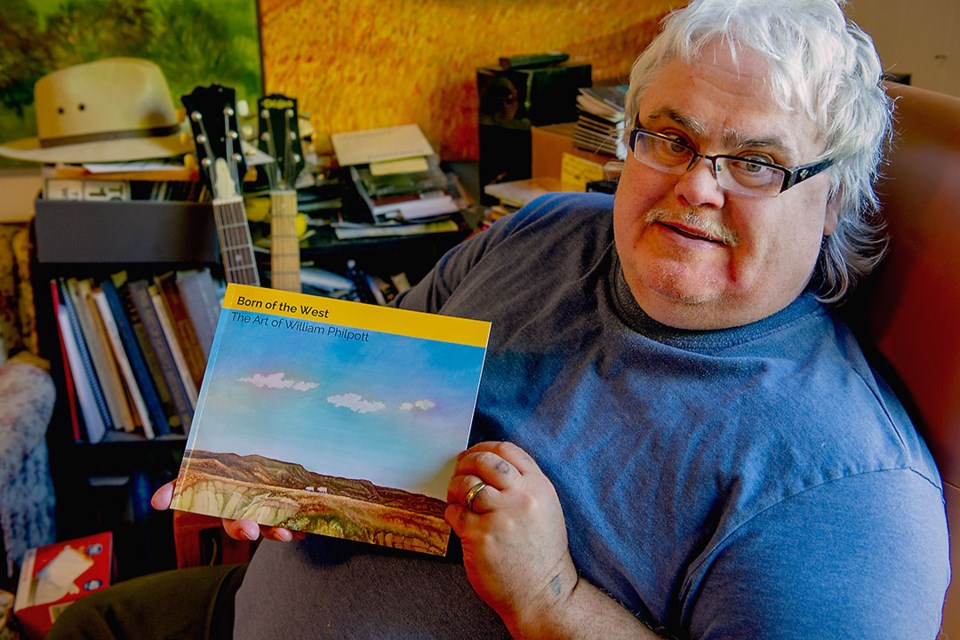Prairie artist and painter William Fred Philpott is a remarkable painter, throughout his career several paintings have been exhibited here in Saskatchewan and throughout other art galleries in Canada.
“Paint what you know,” his father said. These are words that still resonate in his ears and have motivated Philpott in his artistic career.
“I take my sketchbook home, and this gives me my ideas for my paintings,” Philpott said.
He grew up in Central Butte, Saskatchewan and was raised at Butte Lee Farms. His father was an internationally recognized purebred cattleman so most of his childhood was spent on the cattle ranch and observing the life of Saskatchewan’s cow and calf producers. At age three, he started painting. He went to Central Butte School and took a course in commercial arts. He later attended Medicine Hat College for two years of Visual Communications and took a two-year course through Art Instruction School in Minneapolis.
“I paint in an expressive style of Saskatchewan Folk Art, oil on canvas,” Philpott said. He usually works on about six canvases at any given time. Currently, he has about a hundred and fifty finished canvases in his home, which are up for sale. He is also working to complete another fifty paintings that are in progress.
SkArts permanent collection holds a selection his paintings; he has also won numerous awards and his work is exhibited throughout Saskatchewan.
“I was proud to be included in the group exhibition called A Prairie Vernacular at the Moose Jaw Museum and Art Gallery,” said Philpott.
His artistic journey sees him driving around his hometown on Sunday afternoons with his wife Winnie, as he makes sketches at every road stop. These give him constructive ideas for the actual finished work. “I will pull over and grab a sketch pad and ballpoint pen and make diagrammatic sketches of the scene.”
After several sketches of various scenes, he finally comes up with an idea of what he wants to paint.
Philpott takes several journeys every month that he calls “sketching expeditions.”
His painting process starts directly on canvas with wide brushes and oil colour and linseed oil. All his ideas come from the prairie lands of Saskatchewan and the habitats surrounding it. His paintings express his love for rural Saskatchewan.
“I paint from the sketch and by memory, and then I incorporate the stories [that reflect the people who live in this area].”
Philpott likes to add farm elements with animals gazing on the sagebrush-covered hills, farmers fixing fences on their farmsteads, birds playing around the grain bins and relics of the past. He likes to use punches of bright colour mixes like watercolour that drip and run with action movement. He then lets the colours dry overnight as the paintings cure.
After completing this process, he gently coaxes the colours by restraining them. “Like a blazing fire that burns hotter like a glowing ember, I bring it from a flame down to the intensity of a glowing coal.”
Then layers of details are added to add more life to the painting.
“I paint expressively with rural lifestyle being my subject.”
One of his most ambitious projects was a piece of art that consists of four canvases, about two feet high and five feet long for a total of twenty feet end to end. He says his wife was commissioned to paint a panorama of the Beechy Sand Castles, along with some forty kilometres of the length of Lake Diefenbaker near Beechy Saskatchewan. It took him until the end of the following year to complete it. “I went home and completed the full painting by the end of the second year.”
He wants to display this painting in exhibitions even though his wife claimed it.
“I have learned that painting is a passion and [realize that even though I love it, I may not] really make a living from it even as a professional artist,” he said.
In 1985, Philpott’s eleven paintings were exhibited in the province through the Organization of Saskatchewan ARTs Councils (OSAC).
You can view Philpott’s personal paintings or eBooks as digital copies on his website; the original paintings are for sale directly or you can buy a printable wall art that can be reproduced on a computer. If you are interested in viewing his original paintings in-person, you can make an appointment for a tour of his home studio in Central Butte, Saskatchewan. Please text at 639-923-7113. His website can be found at theartofwilliamphilpott.com.


.png;w=120;h=80;mode=crop)

